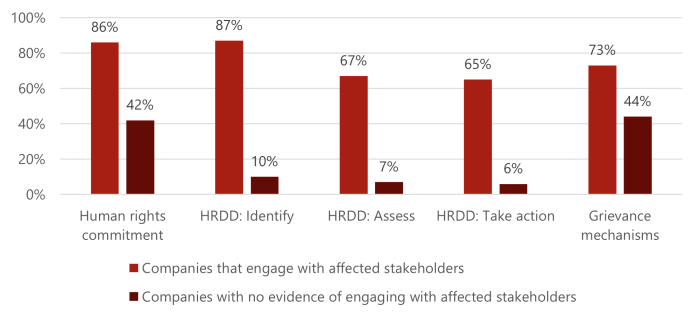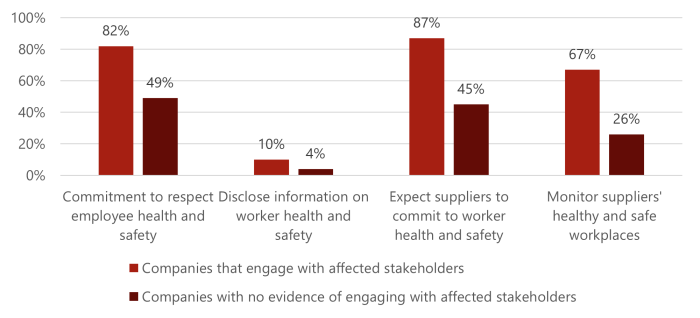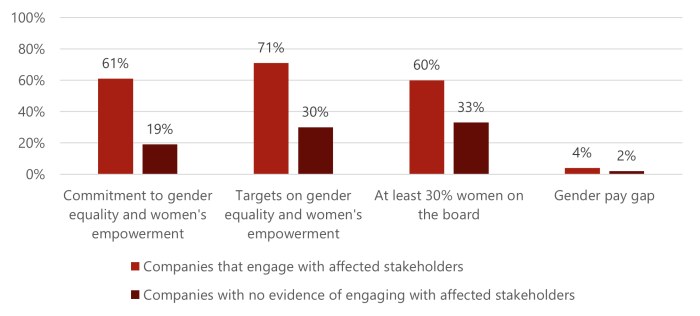Key finding
Engaging with affected stakeholders improves companies’ human rights and decent work practices, yet only 9% of companies do so
In today’s globalised economy, companies interact with and impact many different stakeholders, including employees and trade unions, suppliers, civil society organisations and local communities. Since the decisions and activities of companies can directly impact the human rights of many stakeholders, these individuals should be given an opportunity to voice their views and concerns. The 2030 Agenda recognises the importance of collaboration between all stakeholders to implement the Sustainable Development Goals and calls for the prioritisation of the voices of those who are often left behind. Moreover, both the United Nations Guiding Principles on Human Rights and the Organization for Economic Co-operation and Development’s Due Diligence Guidance emphasise the responsibility of companies to meaningfully consult potentially affected stakeholders on human rights.
By engaging affected stakeholders in dialogue and decision-making processes, companies gain valuable insights into the social and cultural contexts in which they operate, leading to better identification of risks and more effective strategies for mitigation. Moreover, stakeholder engagement fosters trust, transparency and accountability, thereby enhancing the company’s reputation and credibility. Ultimately, robust stakeholder engagement on human rights is not only ethically imperative but also critical for ensuring the long-term sustainability and success of the private sector in an increasingly complex and interconnected world.
Despite these advantages, only 9% of companies in the Social Benchmark communicate examples of how they engage with affected or potentially affected stakeholders. Most of the examples that companies disclose are aimed at trying to understand challenges that employees, supply chain workers and communities face. Companies employ various stakeholder engagement methods to better identify issues, including employee surveys, face-to-face interviews with workers, and anonymous feedback forms from suppliers on purchasing practices. Additionally, there are examples of more targeted engagement on specific issues such as child labour and living wages where companies interview individuals such as teachers and local community leaders to gain diverse perspectives on their challenges.
Companies that engage with affected stakeholders perform better on average across every indicator in the benchmark. Similar to the overall high-performing companies, the trends are strongest across the human rights indicators, including commitments to respect human rights and human rights due diligence. The discrepancy in company performance is most pronounced on the first three steps of HRDD: the identification, assessment and integration of human rights risks and impacts. Similarly, companies that share how they consult affected stakeholders outperform their peers on grievance mechanism availability. While a majority of the 2,000 companies in the benchmark (58%) have a grievance mechanism available for either workers or external individuals to report negative impacts and seek remediation, companies that engage affected stakeholders are nearly twice as likely to have one (73%), compared to companies with no evidence of engagement (44%).
FIGURE 1: PERCENTAGE OF COMPANIES SCORING ON HUMAN RIGHTS INDICATORS

In addition to respecting human rights, companies that consult affected stakeholders outperform their peers on all aspects of providing decent work, with differences being most pronounced on respecting worker health and safety and promoting gender equality and women’s empowerment. There is a correlation between companies that consult affected stakeholders and their likelihood of committing to respecting workers’ health and safety and placing similar expectations on their suppliers. These companies are also nearly three times more likely to monitor their suppliers’ performance on health and safety: 67% of companies engage with affected stakeholders monitoring. Meanwhile, only 26% of companies with no evidence of engagement do so. Although less than 5% of the 2,000 companies disclose worker health and safety data, such as the number and rate of work-related injuries and fatalities, companies that consult affected stakeholders are more than twice as likely to do so.
FIGURE 2: PERCENTAGE OF COMPANIES THAT MEET WORKER HEALTH AND SAFETY FUNDAMENTALS

Companies that engage with affected stakeholders also perform significantly better on gender equality and women’s empowerment. They are over three times more likely to make a public commitment to these issues, such as signing the UN Women’s Empowerment Principles. Additionally, they tend to set time-bound targets on gender equality, such as increasing the proportion of women across various levels of management roles or providing skills training to women workers and community members. Moreover, 60% of the companies that consult affected stakeholders have a board of directors made up of at least 30% women, compared to only 33% of companies that do not have evidence of engagement. Only 2% of the 2,000 companies in the benchmark disclose their global gender pay gap, and we again see that the companies that publish how they engage with affected stakeholders outperform those that do not.
FIGURE 3: PERCENTAGE OF COMPANIES THAT MEET GENDER EQUALITY AND WOMEN’S EMPOWERMENT FUNDAMENTALS

Evidence from our benchmark suggests that engaging with affected stakeholders enables companies to improve their performance across all other areas of socially responsible business conduct. These kinds of consultations help companies to be more in tune with what affected stakeholders want and need. It improves their efforts to align on activities which support and empower impacted individuals, set targets and monitor outcomes to ensure progress is moving in the right direction, and scale up effective measures to benefit even more people.